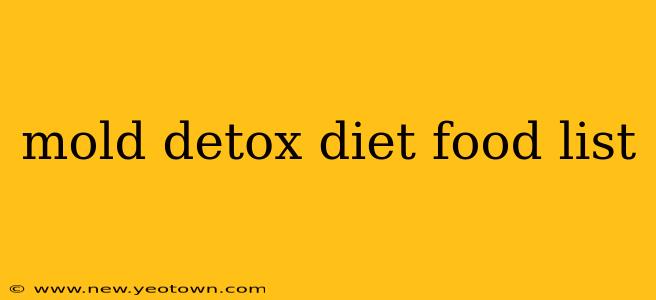Mold Detox Diet: A Food List and Holistic Approach to Supporting Your Body
Imagine this: you've discovered mold in your home, and you're feeling the effects – fatigue, headaches, brain fog, the works. You're ready to take control and support your body's natural detoxification processes. A mold detox diet can be a valuable part of a comprehensive approach, but it's crucial to understand that it's not a magic bullet. It works best in conjunction with professional guidance and environmental remediation. This isn't about eliminating mold toxins overnight, but rather about nourishing your body to better manage its response.
This isn't just a list of foods; it's a story of empowerment, focusing on how the right nutrients can make a difference in your journey towards feeling better. Think of it as fueling your body's inner clean-up crew.
What is a Mold Detox Diet?
A mold detox diet isn't about eliminating specific foods to directly remove mycotoxins (the toxins produced by mold). Mycotoxins are complex molecules, and there's no single diet that magically eliminates them. Instead, this approach focuses on providing your body with the nutrients it needs to support its natural detoxification pathways and reduce inflammation. Think of it as optimizing your body's internal machinery for waste removal, making it better equipped to handle existing mycotoxins and reducing the potential for further damage.
The Power of Nutrients:
This diet emphasizes foods rich in antioxidants, fiber, and nutrients that support liver and kidney function – the primary organs involved in detoxification. These nutrients help your body neutralize and eliminate toxins more effectively. This is about building resilience, not just addressing symptoms.
Foods to Include in Your Mold Detox Diet
This isn't about strict limitations; it's about making informed choices. Here are the food groups that should form the core of your diet:
1. Fruits and Vegetables (the superstars of detoxification):
- Leafy greens: Kale, spinach, collard greens (packed with vitamins and antioxidants)
- Cruciferous vegetables: Broccoli, cauliflower, Brussels sprouts (support liver detoxification)
- Berries: Blueberries, raspberries, strawberries (rich in antioxidants)
- Citrus fruits: Lemons, limes, oranges (boost vitamin C and support immune function)
- Garlic and onions: (contain sulfur compounds that support detoxification)
2. Lean Proteins:
- Fish (especially fatty fish like salmon): Rich in Omega-3 fatty acids, which are anti-inflammatory
- Chicken and turkey: Lean protein sources that support overall health.
- Lentils and beans: Excellent source of plant-based protein and fiber.
3. Healthy Fats:
- Avocado: Healthy fats, fiber, and nutrients supportive of detoxification.
- Olive oil: Rich in monounsaturated fats and antioxidants.
- Nuts and seeds: Provide healthy fats, fiber, and various nutrients.
4. Whole Grains:
- Brown rice: Provides fiber and complex carbohydrates for sustained energy.
- Quinoa: A complete protein and rich in fiber.
- Oats: High in fiber, which helps with elimination.
5. Hydration is Key:
- Water: Aim for plenty of clean, filtered water throughout the day to support the flushing out of toxins.
Foods to Limit or Avoid (While building resilience):
While this isn't an elimination diet, certain foods can put additional strain on your system during detoxification. Consider limiting or avoiding:
- Processed foods: High in unhealthy fats, sugars, and additives.
- Refined sugars: Can impede detoxification processes.
- Alcohol: Can strain the liver.
- Caffeine: Can be stimulating and potentially interfere with sleep, which is crucial for detoxification.
- Dairy (for some): Dairy can be inflammatory for some individuals; consider your individual tolerance.
Frequently Asked Questions (PAAs)
What are the best supplements for mold detox?
There is no single "best" supplement. Some people find support from supplements that assist liver function (like milk thistle), glutathione support, or binders that may help with mycotoxin absorption. It is crucial to consult with a healthcare professional before taking any supplements, especially if you have pre-existing health conditions or are taking other medications. They can guide you on appropriate dosages and potential interactions.
How long does a mold detox diet take?
There's no set timeframe. It's an ongoing process of supporting your body. Your progress will depend on factors like the severity of your mold exposure and your overall health.
Can a mold detox diet cure mold illness?
No, a diet alone cannot cure mold illness. It's essential to address the source of mold exposure through professional remediation of your environment. The diet is a supportive strategy, not a cure.
What if I have allergies or sensitivities?
Pay close attention to your body's responses. If you experience any adverse reactions to certain foods, remove them from your diet and consult a healthcare provider or registered dietitian.
Is a mold detox diet right for me?
This approach can be beneficial for some, but it's not a one-size-fits-all solution. Consult your healthcare provider or a registered dietitian to determine if this is the right strategy for your individual situation. They can help you create a personalized plan that addresses your specific needs and health concerns. Remember, addressing the source of the mold exposure is equally if not more important than any dietary changes.
This journey toward better health requires a holistic approach. Combining dietary changes with professional guidance, environmental remediation, and potentially other medical interventions is the best way to support your body's natural healing process after mold exposure. Remember, this information is for educational purposes and should not be considered medical advice. Always consult with a healthcare professional for personalized guidance.

